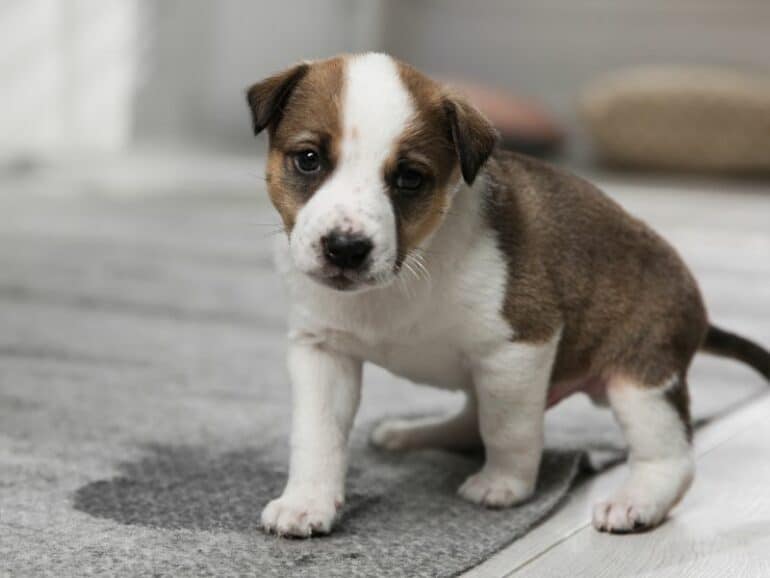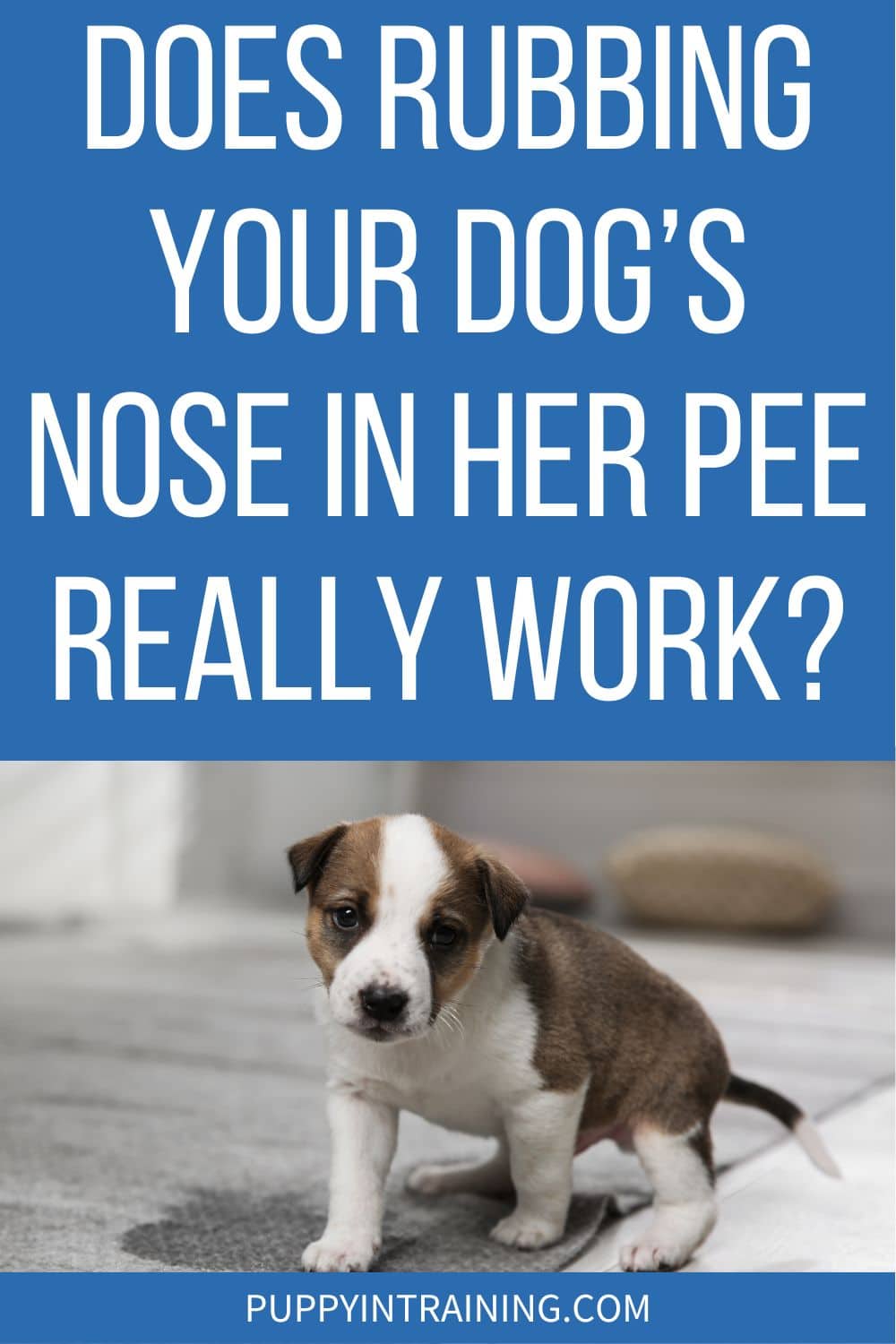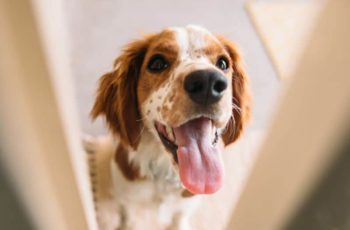This post may contain affiliate links. We may earn money or products from the companies mentioned in this post.
When it comes to housebreaking dogs, there are countless training methods out there, but one that often sparks heated debates is the infamous nose-rubbing technique.
You might have heard about it or maybe even considered trying it, but does rubbing your dog’s nose in her pee really work?
Back when I was a first time dog owner, I remember hearing about this housebreaking method for dogs.

Since housebreaking my Boxer mix puppies Missy & Buzz was at the top of my to-do list, I couldn’t help but wonder if this nose-rubbing approach would be the magic solution.
However, every dog training book I read – and there were quite a few! – said not to rub a dog’s nose in pee.
QUESTION: Does Your Dog’s Nose In Her Pee Really Work?
ANSWER: I’ll come right out and say I witnessed first hand my roommate try nose-rubbing technique for potty training (this was 30 years ago). I can 100% tell you that no rubbing a dog’s nose in her pee did not work for potty training. This can be verified by my ex-roommates pee stained carpets throughout his house.
Why Do People Rub A Dog’s Nose In Pee?
The idea behind it is to make your dog associate the act of urinating indoors with an unpleasant consequence – the discomfort of having her nose rubbed in her own mess.
The hope is that she’ll learn from this negative experience and avoid repeating the behavior in the future.
But like I said, all the dog training literature I read pointed out that there doesn’t seem to be any solid evidence to suggest that rubbing a dog’s nose in pee is an effective training method.
Potential Consequences of Nose-Rubbing
First and foremost, it’s essential to recognize that dogs don’t think like humans!
They don’t comprehend punishment in the same way we do, and using this potty training technique can lead to unintended consequences.
For example, confusion and, in some cases, even more frequent accidents.
Having said that, one of the main concerns with nose-rubbing is the emotional toll it takes on our furries.
After all, dogs are incredibly sensitive creatures, and subjecting them to this punishment can instill fear and anxiety.
The last thing we want is for our dogs to be afraid of us or feel stressed in their own home, right?
As a newbie dog owner who wanted to build a strong bond with Missy and Buzz, I definitely couldn’t bear the thought of potentially damaging our relationship with harsh training methods such as the nose rubbing one.
I wanted a more compassionate and successful approach to housebreaking dogs.
So instead, I combined a specific dog training approach with good old note taking and a few helpful tools.
Positive Reinforcement As A Humane Potty Training Alternative
Enter positive reinforcement!
That’s a powerful dog training approach, and here’s how it works:
Whenever your furry friend goes potty outdoors, shower her with praise, treats, and affection.
This positive association will encourage her to continue peeing (and pooping) in the right place.
With this approach, consistency and patience are key.
During the early stages of housebreaking puppies, you’ll have to provide very frequent potty breaks.
I remember taking the puppies out after every:
- Nap
- Meal
- Crate time
- Play session
I also took them out a couple times in the middle of the night, at least during their first 2 weeks with me.
Since we lived in a third floor apartment back then, I had one puppy under each arm and made my way downstairs and back up.
I wish I had a photo of our nightly potty breaks, but back then, smartphones weren’t really a thing quite yet.
A Consistent Schedule
But anyways, what helped me stay consistent in setting a schedule for bathroom breaks was my puppy potty journal.
It was essentially a notebook that I used to track the pups’ bathroom breaks in.
Back then, I used a physical notebook, but of course a virtual notepad on your phone will do too!
It looked something like this:
- 6am: Both pups peed, Missy pooped
- 7:30 am: Both pups peed, Buzz pooped
- 9 am: Both pups peed, etc.
That way, it was easy to tell which pup had taken care of which business, and it allowed me to predict when they’d have to go out again next.
Because at the end of each day, all that puppy business was nothing but a big blur in my memory!
Crate Training
I already hinted at the fact that I used a dog crate for Missy’s & Buzz’s potty training when I said that they got a bathroom break every time I took them out of their crates.
A crate is a safe and cozy space for your dog, similar to a den for us humans.
As an alternative, you can also use a dog playpen to keep your puppies confined.
Since dogs have a natural instinct not to soil their living area, confining them to a smaller area is a very effective tool for housebreaking.
That is, as long as it’s used within reason!
You don’t want to use it to confine your pups for an unreasonable amount of time.
Keeping that in mind, healthy puppies can usually hold it one hour longer than their age in months.
So if your puppy is 2 months old, they should be able to hold it for 3 hours.
Good to know: Adult dogs shouldn’t be crated for any longer than 5 hours without getting an opportunity to stretch their legs and relieve themselves.
If you or a family member can’t take them out for a potty break yourselves, consider hiring a professional dog walker or asking a friendly neighbor.
Fun fact: I worked as a professional dog walker and pet sitter for 9 years and even ran my own business. It was a lot of fun but also a lot of work, especially when clients hired me to help them care for their puppies!
For more information on crate training a puppy, click here.
Enzymatic Cleaners For Dog Urine
In addition to positive reinforcement training, a consistent potty schedule and crate training, there are several products that can help you housebreak your puppy.
For starters, you can use enzymatic cleaners for dog urine to clean up any indoor accidents right away.
These cleaners effectively remove odors, which helps reduce the chances of your dog peeing (or pooping) on the same spot.
Our favorite ones are:
Good Dog Housebreaking Aid
Once you’ve cleaned up the accident, you can add another layer of protection by treating it with sprays that have a repellent scent.
They’re also known as good dog housebreaking aids.
For example:
Since they’re made with scents dogs don’t care for, it helps keep them away from the area.
You can also use these sprays as a preventative method and use them in areas where you don’t want your dog to pee or poop.
Another alternative could be a DIY solution that consists of equal parts water, white vinegar and lemon juice!
How Do You Discipline A Puppy For Peeing On The Floor?
So now that we’ve established that you shouldn’t rub a dog’s nose in pee, is there anything else you can do to discipline your puppy?
After all, we do want them to know that what they did is not OK.
First of all, keep in mind that puppies have a limited ability to control their bladder, and that accidents are a normal part of the house-training process.
Having said that, the most important piece of advice I can share with you here is that you have to catch your puppy in the act and redirect them to the appropriate spot.
That means you’ll have to closely supervise your puppy.
When you do catch them in the act, say something like “no” or “ah ah” in a firm voice, but without yelling.
You can also make a gentle noise to interrupt them.
Immediately take them outside and reward them for peeing there.
You may have to wait a moment since they just relieved themselves inside, but hey, patience is part of raising puppies!
Now, if you don’t catch your puppy in the act, there’s no point in no-ing them 10 minutes later.
At that point, they won’t understand what they did wrong, and it may confuse them or lead to anxiety.
Bottom Line
In conclusion, while the idea of rubbing your dog’s nose in her pee might have been a common training technique in the past, there are more compassionate and effective options.
After all, punishing our furry friends for their natural bodily functions can lead to fear and anxiety and have the opposite effect of what we’re trying to achieve.
So instead, let’s focus on building trust and a loving bond with our pups by doing the following:
- Supervise closely
- Use positive reinforcement
- Create a consistent schedule
- Redirect and interrupt accidents
- Avoid punishing after the fact
- Clean accidents properly
- Use crates or playpens as confinement areas
- Be patient and consistent
Remember, positive reinforcement and consistency are key when training a puppy.
With time, patience, and consistent effort, your puppy will learn where it’s appropriate to pee and develop good house training habits.
Save To Pinterest

Top Picks For Our Puppies
- BEST PUPPY TOY
We Like: Calmeroos Puppy Toy w/ Heartbeat and Heat Packs – Perfect for new puppies. Helps ease anxiety in their new home. - BEST DOG CHEW
We Like: Mighty Paw Naturals Bully Sticks – All of our puppies love to bite, nip, and chew. We love using Bully Sticks to help divert these unwanted behaviors. - BEST DOG TREATS
We Like: Crazy Dog Train-Me Treats – We use these as our high-value treats for our guide dog puppies. - BEST FRESH DOG FOOD
We Like: The Farmer’s Dog – A couple months ago we started feeding Raven fresh dog food and she loves it! Get 50% off your first order of The Farmer’s Dog.
Check out more of our favorites on our New Puppy Checklist.


